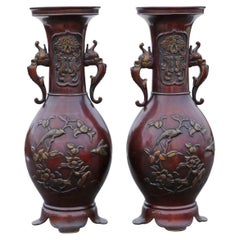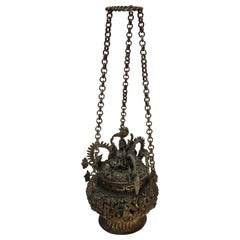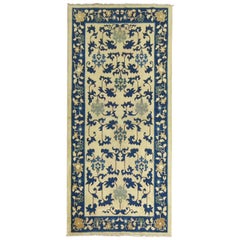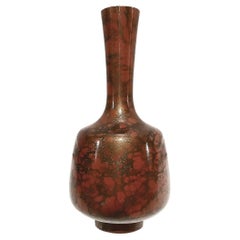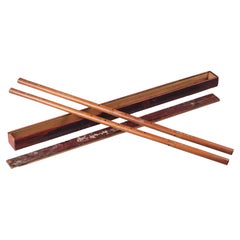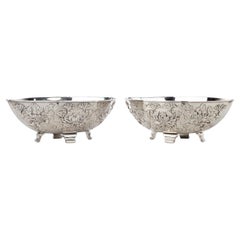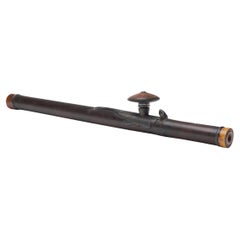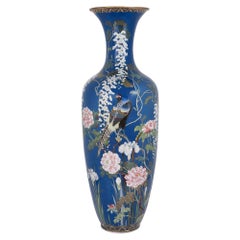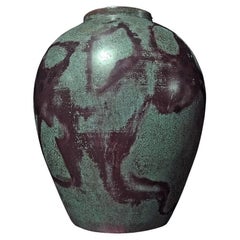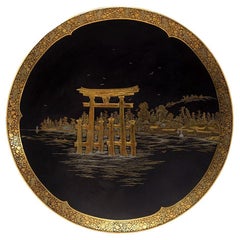1910s More Asian Art, Objects and Furniture
to
2
4
3
7
345
732
738
171
333
184
55
37
7
21
6
14
13
17
13
4
5
4
2
1
1
1
6
6
3
2
1
7
7
7
Period: 1910s
Antique Very Large Pair of Japanese Bronze Vases Meiji Period
Located in Wisbech, Cambridgeshire
Antique very large pair of fine quality Japanese bronze vases C1910 Meiji Period.
Would look amazing in the right location. Rare large size and design.
Overall maximum dimensi...
Category
Japanese Meiji Vintage 1910s More Asian Art, Objects and Furniture
Materials
Bronze
$1,722 Sale Price / set
30% Off
Tibetan Bronze Incense Burner Finely Detailed with Mythical Beasts circa 1910
Located in Central England, GB
A Tibetan Bronze Incense Burner
This highly decorative piece is made from cast bronze which has a dark patina and Verdigris finish. It is cast with fine detail with figures and my...
Category
Tibetan Tibetan Vintage 1910s More Asian Art, Objects and Furniture
Materials
Bronze
Ivory Blue Chinese 20th Century Throw Rug
Located in New York, NY
An early 20th century Chinese peking throw rug. Cream field with blue accents.
3' x 5'10''
Category
Chinese Tibetan Vintage 1910s More Asian Art, Objects and Furniture
Materials
Wool
$2,800 Sale Price
20% Off
Japanese Brass Ikebana Vase, Early 20th Century
Located in New York, NY
A fabulous Ikebana brass vase, hand-crafted in Japan, Showa Period. The finish is Murashido, a centuries-old technique that consists in dipping the cast brass in oil and smoke it wit...
Category
Japanese Showa Vintage 1910s More Asian Art, Objects and Furniture
Materials
Brass
Pair of Chinese Bamboo Vertical Flutes ‘Xiao’
Located in London, GB
Pair of Chinese Bamboo Vertical Flutes ‘Xiao’ each Inscribed in Their Original Box Inscribed ‘Made by Zhang Lunshan of Yuping Guizhou’
A Scholar’s Object
Early Republic / Circa 1912 - 1920
SIZE: 62cm long - 24½ ins long (each)
case: 4cm x 4.5cm x 65cm long - 1½ ins x 1¾ ins x 25½ ins long
The Chinese province of Guizhou is famous for its excellent bamboo flutes which are a symbol of the Chinese scholar. Its sound was sacred and was traditionally said to be carried by one of the eight immortals called Han Xiangzi. Each flute is inscribed with a poem extolling the inspiring sound that it produces and of the beauty of the ‘Jade Lady...
Category
Chinese Vintage 1910s More Asian Art, Objects and Furniture
Materials
Bamboo
Pair of Meiji Period Solid Silver Bowls by Eigyoku
Located in Lymington, Hampshire
A pair of Meiji period solid silver bowls by Eigyoku, each of lobed oval form on four scroll feet, deeply embossed with continuous chrysanthemum hea...
Category
Japanese Meiji Vintage 1910s More Asian Art, Objects and Furniture
Materials
Silver
$26,318 / set
Shoehorn from USA
Located in Sagaponack, NY
A nickeled brass shoehorn with a faux-tortoiseshell handle
Category
American Vintage 1910s More Asian Art, Objects and Furniture
Related Items
Chinese Bamboo Opium Pipe with Red Clay Bowl
Located in Chicago, IL
This long bamboo pipe dates to the late 19th century and was originally used for smoking opium. Unlike a tobacco pipe, the opium pipe was designed especially to allow resinous opium ...
Category
Chinese Qing 1910s More Asian Art, Objects and Furniture
Materials
Brass
Very Large Japanese Meiji Period Cloisonne Enamel Vase
Located in London, GB
This stunning Meiji period vase is a wonderful example of the quality of craftsmanship during the late 19th century Japanese Meiji period. The Meiji era was famed for being the perio...
Category
Japanese Meiji Antique 1910s More Asian Art, Objects and Furniture
Materials
Enamel
Antique Signed Japanese Meiji Period Mixed Metals Bronze Double Gourd Form Vase
Located in Philadelphia, PA
A fine antique Japanese bronze vase.
From the Meiji Period.
With copper and silver floral and vine and butterfly inlay as well a kanji symbol to the neck (possibly a stylized f...
Category
Japanese Meiji 1910s More Asian Art, Objects and Furniture
Materials
Silver, Bronze, Copper
$895
H 6.88 in Dm 3.88 in
Chinese Antique Bamboo Basket with Painted Lid
Located in Somis, CA
Beautiful two-tier basket features painted, gilded images of an opera scene showing a victorious battle. Basket is lacquered in cinnabar, a special mix of ...
Category
Chinese Antique 1910s More Asian Art, Objects and Furniture
Materials
Wood, Bamboo
Tibetan Flint Striker, C. 1850
Located in Chicago, IL
In 19th-century Tibet, many men carried a fire striker to help ensure survival in the often-harsh climate of the Tibetan Plateau. Known as mechag, such strikers would hang from one's belt and often doubled as a small pouch for flint and tinder. The finest strikers were finished with precious metals and decorated with repoussé and inlaid stones.
This leather flint pouch is decorated with silver and gold plated metalwork and three large beads of turquoise and red coral. The mechag hangs from a simple leather strap and three decorative leather beads hang below. The pouch contains two Tibetan prayer flags...
Category
Tibetan Tibetan Antique 1910s More Asian Art, Objects and Furniture
Materials
Coral, Gold Plate, Steel, Metal
Japanese Meiji Period Sterling Silver 2 Handled Basket by Katsu Miyamoto
Located in Dallas, TX
PRESENTING a GORGEOUS, VERY HIGH QUALITY and EXTREMELY RARE piece of Japanese Meiji Period Sterling Silver 2 Handled Basket by Katsu Miyamoto.
EXQUISITE, EXCEPTIONAL, RARE & IMPORTANT!
This is definitely a Meiji Period piece due to the fact that it is marked with the sterling silver mark “jungin”.
The Meiji period was from 1868 to 1912 and in 1928 a law was introduced in Japan compelling the use of decimal marks for silver.
This pre-dates that decimalization law.
We are of the opinion that it is from circa 1900.
Miyamoto Shoko was founded in 1880 as the first silverware specialty shop. In 1899, Miyamoto Shoko’s silverwares were ordered by the family members of the Emperor of Japan, and to this day, they are making fine and graceful handicrafts with skillful craftsmen.
Loved by numerous customers since the Meiji era, Miyamoto Shoko’s products have also been given to Princess Mako and Princess Kako of Akishino, as well as Princess Aiko Toshinomiya, on their birthdays.
Katsu Miyamoto (宮本勝), in 1880, in order to increase the sales of tobacco and cigarettes to foreigners founded the Moyamoto Shoko company, which produced different silverwares in general and particularly silver cigarette cases. Miyamoto’s first name, Katsu (勝) in some sources is written as “Masaru”, since 勝 kanji can be pronounced in both ways.
This basket is of the HIGHEST QUALITY imaginable!
The top of the basket has the MOST GORGEOUS repousse work of flowers, probably lotus flowers, with leaves and foliage. It has an underlying chevron effect chasing, reflecting parquetry.
The 2 handles are cast in the form of bamboo handles.
The rim of the top likewise is cast as bamboo.
The base is equally stunning in a different way!
It is chased with a chevron effect, like parquetry flooring and the four feet simulate pieces of sliced bamboo with an interlinking gallery of support columns, likewise, simulating bamboo.
The QUALITY of WORKMANSHIP is OUTSTANDING!
The pieces weighs exactly 525 grams.
This piece takes my breath away!
This is one for the SERIOUS COLLECTOR of EXQUISITE AND RARE Japanese silver. You will not find another like it, for sale ANYWHERE ELSE IN THE WORLD …… I know as I have searched!
Provenance: Acquired from a Dallas Private Collector.
Dimensions: 9.6 inches wide, 7.6 inches deep and 2.75 inches tall ( 7.25 inches tall with handles up)
Condition: Very good. It looks like the base 4 legged gallery, has been repaired/re-attached to the base, but otherwise it is excellent and of Museum quality.
The Meiji period (明治時代 Meiji-jidai?), also known as the Meiji era, is a Japanese era which extended from October 23, 1868 through July 30, 1912.[1] This period represents the first half of the Empire of Japan during which Japanese society moved from being an isolated feudal society to its modern form. Fundamental changes affected its social structure, internal politics, economy, military, and foreign relations. The period corresponded with the reign of Emperor Meiji after 1868, and lasted until his death in 1912. It was succeeded by the Taishō period upon the accession of Emperor Taishō to the throne.
Solid silver pieces...
Category
Japanese Meiji 1910s More Asian Art, Objects and Furniture
Materials
Sterling Silver
$7,250
H 7.25 in W 9.6 in D 7.6 in
Framed Antique Tibetan Buddhist Thangka
Located in Atlanta, GA
A stunning antique Tibetan Thangka with an embroidered border, circa mid to late 19th Century. It depicts Yamantaka or Vajrabhairava, a wrathful manifestation of Manjusri, the bodhisattva of wisdom, and in other contexts functions as a dharmapala, or 'Dharma-protector'. The buffalo head deity Vajrabhairava is one of the three principal meditation deities of the Gelug School. He is shown with nine faces in the Yab Yum...
Category
Tibetan Tibetan Antique 1910s More Asian Art, Objects and Furniture
Materials
Textile, Acrylic
Mid-20th Century Handmade Chinese Art Deco Pictorial Dragon Throw Rug
Located in New York, NY
A vintage Chinese Art Deco throw rug handmade during the mid-20th century with a pictorial design of a dragon in black, blue, red, goldenrod, and light blue-grey over a cream-white borderless field.
Measures: 1' 3" x 1' 6"
The craft of the hand-knotted carpet in China, and the surrounding areas including Mongolia and Tibet, extends into the early centuries of the first millennium, C.E., but we really have a firm grasp only beginning in the later 16th century with large, very coarsely woven carpets, often depicting dragons, created for the Imperial Forbidden City palaces. Chinese carpets have always been commercial and there are no tribal groups responsible for any of the carpet weaving strains.
When the Ming Dynasty fell in 1644, with no Imperial patrons, production moved to the city of Ningxia in north central China where several workshops turned out more finely woven pieces for the Mandarins of the administrative Ch’ing bureaucracy and well-to-do merchants. Ningxia was the major Chinese carpet center up through most of the 19th century, with first allover and then medallion designs on cotton foundations in medium weaves. Palettes were initially limited to yellows, dark blue and cream, but later widened to include reds, browns and even green. These antiques were the first Chinese carpets to be exported to the West and they fitted in well with the craze for Chinese blue-and-white porcelain in the second half of the 19th century. Ningxia also wove shaped and rectangular small rugs for saddle underlays, chair (“throne”) seats and shaped backs, pillar carpets with dragons or monks for Buddhist monasteries, and long divided runners for monastery meditation halls. These small rugs are among the most collectible of all Chinese weavings.
Weavers from Ningxia set up workshops in the capital Peking (Beijing) in the 1860’s and began weaving Western room sizes for export, primarily to America. In blue – and – white and polychrome palettes, with round wreath medallions, precious objects, seasonal flowers, paeonies, lotuses, fretwork, clouds, butterflies and bats, all relatively spaciously drawn. The round “Shou” (Good Luck) character is also a prominent decorative motif. There are also a few Peking landscape pictorials with pagodas, houses, bridges, waterscapes and boats. Peking carpets were woven right up until WWII and production began again after the Cultural Revolution around 1970. They are moderately well-woven, on cotton foundations, exactingly executed and indisputably Chinese. Many are in the blue-and-white style. Nothing else looks like a Peking carpet and for a Chinese “look” in a room, they are absolutely indispensable. Sizes range from scatters and a few runners, through the popular 9’12’ size, to large carpets over 20’ which must have been special orders. The earliest Peking Revival carpets are pliable and fairly thin, but they became heavier and more compact in the 20th century, in competition with Art Deco carpets from Tientsin. The modern, post- 1970, pieces are in the traditional Peking style, but are a little too regular and neat. Exactitude has been favored over character, as hard to explain that as it is.
There are a number of all-silk and silk-and –metal thread pieces, many with inscriptions purporting to link them with rooms in the Imperial palaces, bringing very substantial auction prices, but none are really antique. The genre emerged after WWI and the present demand comes from mainland Chinese. The silk piles often stand in pattern relief against flat woven gold metal thread grounds. The inscriptions are apocryphal, the rugs are flashily opulent, perfect for nouveaux riches.
The Art Deco period between the two World Wars saw a distinctive carpet industry developing in Tientsin (Tianjin) in northeastern China. These are highly prized for their transitional design character, neither overtly Chinese, nor abstractly modern/contemporary. Woven exclusively for export, usually by and for American firms, such as Nichols and Elbrook, they are totally in the “Jazz Age Modern” style of the 1920’s, often without borders, with abstract or abstracted patterns, and only with, at best, a few Chinese-y pattern elements. Vases asymmetrically placed in the corners are features of some of the more Chinese-y carpets. Open fields with floral sprays and branches growing in from the edges are anther design innovation. Often, Chinese motives have been re-imagined in more sharp-edged, abstract manners. Some have no references whatsoever to natural elements. The patterns are sharp and the rugs are never subdued, soft or restrained. The rugs are heavily constructed, with crisp, unfading dyes and medium to medium coarse weaves on cotton foundations. All are extremely well-executed, with none of the vagaries, variations or twists found on even high-quality Persian rugs. The majority are in the 9’ by 12’ format and a surprising number can be found in top condition. There also was a substantial production in Peking from, especially from the Fette factory. Elliptical and round carpets, and lighter, often pastel colors, were a specialty. Nothing looks like an Art Deco Chinese and they work well with traditional Chinese furniture and the most modern decor as well. These is no substitute for a good Chinese Art Deco carpet.
Chinese carpets also include small scatters from Tibet, with high quality wool, floating dragons and allover textile patterns. The colors of vintage and modern pieces are bright, but there are antique small rugs...
Category
Chinese Art Deco 1910s More Asian Art, Objects and Furniture
Materials
Wool
$1,100 Sale Price
20% Off
W 15 in L 18 in
Japanese Silver Incense Burner, Akoda Koro, by Nomura, Meiji Period, Japan
Located in Austin, TX
A lovely and luxurious Japanese silver incense burner of lobed melon form, akoda koro, marked jungin and signed Nomura, Meiji Period, circa 1900, Japan.
The silver koro...
Category
Japanese Meiji Vintage 1910s More Asian Art, Objects and Furniture
Materials
Silver, Sterling Silver
Early 20th Century Chinese Rug
Located in West Hollywood, CA
This traditional hand-woven Chinese rug has a café-au-lait field with meandering rust vine issuing polychrome sunflowers and delicate stylized leaves, in a plain rust red border.
Category
Chinese 1910s More Asian Art, Objects and Furniture
Materials
Wool
Large Pair of Meiji Period Japanese Cloisonne Enamel Double Dragon Vases
Located in Queens, NY
A large pair of Meiji Period Japanese Cloisonne Enamel Double Dragon Vases, 19th century.
Japanese cloisonne enamel dragon vases are highly ...
Category
Japanese Meiji Antique 1910s More Asian Art, Objects and Furniture
Materials
Copper, Enamel
Jade Carving Group Finely Carved
Located in Somis, CA
This special collection comprises a three-dimensional celadon jade carving of a magpie perched on plum blossom branches, symbol of happiness; a Ruyi shap...
Category
Chinese 1910s More Asian Art, Objects and Furniture
Materials
Jade
Previously Available Items
Japanese Brass Ikebana Vase, Early 20th Century
Located in New York, NY
A fabulous Ikebana brass vase, hand-crafted in Japan, circa 1920. Taisho Period. The finish is Murashido, a centuries-old technique that consists in dipping the cast brass in oil and...
Category
Japanese Taisho Vintage 1910s More Asian Art, Objects and Furniture
Materials
Brass
Japanese Meiji Period Iron Charger Komai Workshop
Located in Newark, England
Fine Japanese iron charger dating to the late Meiji period. The charger boldly decorated with an outer boarder of gilt leaves surrounding the central scene of the world-famous Itsukushima Shrine also known as the Great Torii of Miyajima. The charger is inlaid with gold and silver accents with the Torii gate featuring to the centre foreground and the Hoden (main hall) and Heiden (offertory hall) in the background.
The Shinto Shrine of Miyajima is best known for its floating Torii gate. It is located in the city of Hatsukaichi in Hiroshima prefecture Japan. The entire shrine complex is listed as a UNESCO world heritage site, with the Japanese government designating several buildings and possessions as national treasures. The shrine is one of Japanese most popular tourist attractions and is accessibly by ferry at Miyajimaguchi station. In total the shrine complex consists of two main buildings, the Honshu shrine and the Sessha Maraodo-jinja, as well as 17 different buildings and structures.
There is some discussion as to when the shrine was originally built with some indication stating it was built by Saeki Kumamoto in 593 during the reign of Empress Suiko (592-628 CE) however more recently the shrine has been attributed to Taira no Kiyomori, a prominent nobel of the Imperial Court and later Chancellor Daijō-daijin, who heavily contributed to the construction of the shrine during his time as governor of Aki province in 1168.
This scene is featured on several Japanese artwork...
Category
Japanese Meiji Vintage 1910s More Asian Art, Objects and Furniture
Materials
Metal, Gold, Silver, Iron
Japanese Brass Vase, Early 20th Century
Located in New York, NY
A hand-cast brass Ikebana vase, circa 1910-1920. Japan, Showa period.
Its clean lines reflect the precision and elegance of Japanese craftsmanship. The finishing is Murashido "hot-...
Category
Japanese Showa Vintage 1910s More Asian Art, Objects and Furniture
Materials
Bronze
Japanese Murashido Brass Vase, Early 20th Century
Located in New York, NY
A hand-cast brass Ikebana vase, circa 1910-1920. Japan, Showa period.
Its clean lines reflect the precision and elegance of Japanese craftsmanship. The finishing is Murashido "ho...
Category
Japanese Showa Vintage 1910s More Asian Art, Objects and Furniture
Materials
Bronze
Antique Japanese Traditional 'KIMEKOMI' Doll Taisho Era 1912-1926s
Located in Paris, FR
This is a traditional Japanese doll with kimono called 'Kimekomi ningyo', made in Taisho era around 1912-1926s.
Kimekomi dolls are made of woods. The c...
Category
Japanese Vintage 1910s More Asian Art, Objects and Furniture
Materials
Wood
Chinese Four-Panel Screen in Teak Wood Frame
Located in Savannah, GA
Four 19th century Chinese hand-painted panels on silk in a hand-carved footed teak wood frame featuring a carved lotus at the top. Strong vivid colors with much detail. The back is c...
Category
Chinese Qing Vintage 1910s More Asian Art, Objects and Furniture
Materials
Silk, Teak
Antique Large Oriental Japanese Bronze Mixed Metal Jardinière Planter Meiji
Located in Wisbech, Cambridgeshire
Antique large fine quality Oriental Japanese bronze mixed metal Jardinière planter bowl censor C1910 Meiji Period. Signed artist piece.
Would look amazing in the right location an...
Category
Japanese Vintage 1910s More Asian Art, Objects and Furniture
Materials
Bronze
Antique Large Oriental Japanese Bronze Champleve Enamel Jardiniere Planter Meiji
Located in Wisbech, Cambridgeshire
Antique large quality Oriental Japanese bronze champleve enamel Jardiniere planter bowl C1910 Meiji Period.
Would look amazing in the right location. Rare large size and design.
...
Category
Japanese Vintage 1910s More Asian Art, Objects and Furniture
Materials
Bronze
Japanese Murashido Brass Vase, Early 20th Century
Located in New York, NY
A hand-cast brass Ikebana vase, circa 1910-1920. Japan, Showa period.
Its clean lines reflect the precision and elegance of Japanese craftsmanship. The finishing is Murashido "ho...
Category
Japanese Showa Vintage 1910s More Asian Art, Objects and Furniture
Materials
Bronze
Chinese Wooden Vase Stand with Elephant Trunk Legs
Located in London, GB
Elaborate early 20th Century Chinese hard wood hand carved vase stand. The stand has five legs as elephant's trunks, with a articulated apron.
Provenance;
Purchased from Loyd-Pa...
Category
Chinese Vintage 1910s More Asian Art, Objects and Furniture
Materials
Hardwood
Chinese Mahogany and Carved Jade Tray
Located in Lambertville, NJ
An antique Chinese carve wood and carved jade handled tray. The hand carved bamboo motif frame work with carved jade panels fitted all around. Marked on th...
Category
Chinese Chinese Export Vintage 1910s More Asian Art, Objects and Furniture
Materials
Jade
Pair of Antique Chinese Cloisonne Vases, circa 1910
Located in Lambertville, NJ
A pair of antique Chinese baluster form cloisonné vases with blue background. The floral fronts with leafy branches with a small floral decoration on the backs. One with a green bord...
Category
Chinese Chinese Export Vintage 1910s More Asian Art, Objects and Furniture
Materials
Copper
Recently Viewed
View AllMore Ways To Browse
Vintage 2 Piece China Cabinet
Vintage Bone Rings
Vintage Brass Mirrored Tray
Vintage Carnival Posters
Vintage Curio Shelf
Vintage Dessert Trolley
Vintage Fireworks
Vintage Formica Kitchen Table 1960s
Vintage Fresnel Light
Vintage Gas Signs
Vintage German Decanter
Vintage Hand Painted Metal Trays
Vintage Indonesian Cabinets
Vintage Inflatable Furniture
Vintage Mexican Ornaments
Vintage Model Airplanes
Vintage Pool Chair
Vintage Round Outdoor Dining Table
